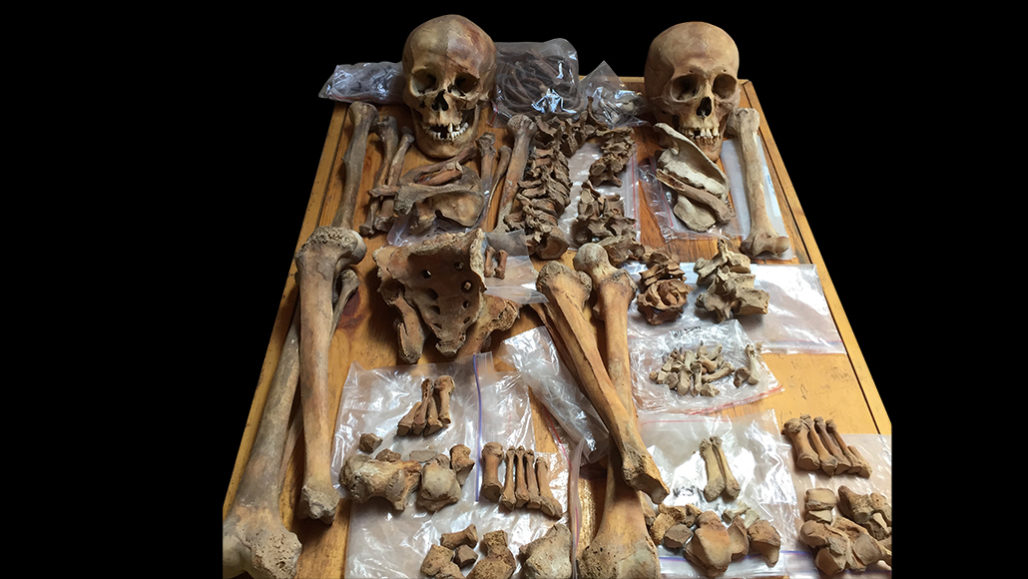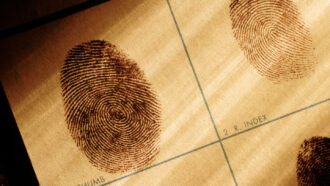Skeletons hint that ancient societies had women warriors
Traditional views of women as homemakers may be flawed

The skeleton of a woman (left) buried in an ancient Mongolian tomb suggests she may have been a horse-riding, arrow-slinging warrior.
C. Lee
By Bruce Bower
History has suggested ancient societies left warfare to men. But remains of North American hunter-gatherers and Mongolian herders now suggest differently. Skeletons show signs that some women in these communities were warriors.
Long ago, societies assigned certain jobs to men and women. But these roles were not strictly enforced, two new studies suggest. Anthropology is the study of human societies. It long held that hunters were men and gatherers were women. But that view now appears flawed and too simple, says Marin Pilloud. She is a forensic anthropologist who works at the University of Nevada, Reno.
She and other scientists had planned to share their new findings at a scientific meeting in April. But the meeting was canceled due to the coronavirus pandemic. The scientists now describe their research to Science News for Students.
Bone clues
Groups of hunter-gatherers lived in central California from 5,000 to 200 years ago. Pilloud and her colleagues examined more than 400 skeletons of people from 19 of those groups.
Archaeological evidence helped shape the popular view of those groups. So did history and descriptions of these people by 20th century anthropologists. They portrayed men as hunters, fishers and fighters in tribal feuds and other conflicts. They described women as gatherers, weavers and child caretakers. But 128 of the skeletons from hunter-gatherer women showed damage from arrows and sharp objects, such as knives. Pilloud’s team found similar injuries on 289 male warriors.
The skeletons belong to a database of remains. They come from more than 18,000 hunter-gatherers. Back in 2014, Pilloud and others reported finding that about 11 percent of males in that database had violent injury from a sharp object. In contrast, only 4.5 percent of females did. Pilloud’s newer findings show similar patterns of those injuries on the skeletons of men and women.
Bones on their own can’t tell scientists whether women fought next to men. Some females might have been injured carrying out other dangerous battle duties. For instance, maybe they snuck up on enemies to cut their bow strings.
In wars between Native American tribes in California, women often were killed in surprise raids and other attacks. That may partly explain female injuries reported in the new study, says Patricia Lambert. She is a biological anthropologist at Utah State University in Logan. Lambert was not part of Pilloud’s team.
Or, Lambert says, some women may have fought in battles to defend their children or village. What might strengthen the case for female fighters? Women buried, she says, with weapons and other battle artifacts.
A long history
Mongolia is wedged between lower Russia and upper China. In ancient times, herding nomads there trained some women to be warriors. That’s the finding of a second new study. These herders had lived between A.D. 147 and 522. This was a time of frequent warring.
Christine Lee is an anthropologist. She works at California State University, Los Angeles. Her team studied the remains of three women and six men buried in a high-status Mongolian tomb. All but one woman showed signs of having ridden horses in combat.
Some bones were altered by frequent horse riding or damaged from falls off horses. Bones in the shoulders and chests of two of the Mongolian women showed signs of having used bows to shoot arrows. Their faces and heads also had arrowhead injuries.
In the past, looters had raided the tomb in which these bones were found. So any war-related objects that may have been buried with the bodies are long gone. Graves of potential women warriors in western Asia include weapons and war gear.
By around 900, Mongolian women fought in wars and held political power, Lee says. She suspects that freedom for Mongolian women goes back at least 400 more years.
Lee plans to look for female warriors in more Mongolian tombs. Some of them date to as early as around 2,200 years ago. She suspects that women warriors “may go back a long way in northern Asian nomadic groups.”







